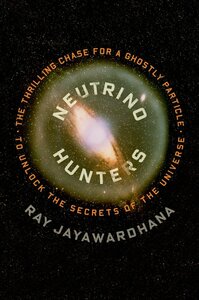Take a photo of a barcode or cover
16 reviews for:
Neutrino Hunters: The Thrilling Chase for a Ghostly Particle to Unlock the Secrets of the Universe
Ray Jayawardhana
16 reviews for:
Neutrino Hunters: The Thrilling Chase for a Ghostly Particle to Unlock the Secrets of the Universe
Ray Jayawardhana
Absolutely loved it!
If you're interested in the future of physics, this is the book for you.
If you're interested in the future of physics, this is the book for you.
I was so excited to pick up this book: an entire pop-sci text dedicated to neutrino experiments? Just what I was looking for!
Unfortunately I found the book very unbalanced.
The opening chapter, covering the inception of the IceCube Neutrino Observatory in Antartica was well done and really imparted the awesome scale and ambition of the experiment. I think this is probably the best chapter of the book.
Unfortunately things start taking a turn when the book starts writing lengthy biographies of tangential characters. I'm pretty sure I know what happened here. Jayawardhana wanted to give a sense of history and context to the neutrino discussion so he branched out. But goodness does every physics pop-sci need a section on Emmy Noether? Does this book need an extensive biography of Paul Dirac or Bruno Pontecorvo?
For its excesses in these topics it also ends up skimping on the subtleties. I doubt the average reader would have come away from this understanding any more about the theoretical grounding of these particles than they entered. Something I was looking forward to - a pop-sci explanation of oscillation and mass eigenstates - was reduced to a Napolitano ice cream analogy and dispensed with in a few lines.
Towards the end of the book a lot more time is spent on astrophysics and stellar evolution which isn't something I've heard a lot about since undergraduate and I decided this book might end on a high note.
My rating though reflects my experiences with the last chapter and ultimately the impression i came away from this book with. It's a long list of all the things Jayawardhana wanted to talk about and ran out of time for. Or couldn't fit into the main text.
For that the book dropped from a 3-star read to a 2.5.
Sad to not have enjoyed this.

Learn more about IceCube here: https://icecube.wisc.edu/about/overview
Unfortunately I found the book very unbalanced.
The opening chapter, covering the inception of the IceCube Neutrino Observatory in Antartica was well done and really imparted the awesome scale and ambition of the experiment. I think this is probably the best chapter of the book.
Unfortunately things start taking a turn when the book starts writing lengthy biographies of tangential characters. I'm pretty sure I know what happened here. Jayawardhana wanted to give a sense of history and context to the neutrino discussion so he branched out. But goodness does every physics pop-sci need a section on Emmy Noether? Does this book need an extensive biography of Paul Dirac or Bruno Pontecorvo?
For its excesses in these topics it also ends up skimping on the subtleties. I doubt the average reader would have come away from this understanding any more about the theoretical grounding of these particles than they entered. Something I was looking forward to - a pop-sci explanation of oscillation and mass eigenstates - was reduced to a Napolitano ice cream analogy and dispensed with in a few lines.
Towards the end of the book a lot more time is spent on astrophysics and stellar evolution which isn't something I've heard a lot about since undergraduate and I decided this book might end on a high note.
My rating though reflects my experiences with the last chapter and ultimately the impression i came away from this book with. It's a long list of all the things Jayawardhana wanted to talk about and ran out of time for. Or couldn't fit into the main text.
For that the book dropped from a 3-star read to a 2.5.
Sad to not have enjoyed this.

Learn more about IceCube here: https://icecube.wisc.edu/about/overview
This book does a good job of surveying the past, present, and future of neutrinos. It includes a history of the early theoretical proposals positing the existence of neutrinos and the subsequent early experimental detections. It then moves into recounting the story of the "solar neutrino deficit" and the implications of its resolution. In doing so, it describes the past and present generation of neutrino detectors like Davis's Homestake mine experiment, SuperK in Japan, IceCube in Antarctica, and SNOLAB in Canada.
My favorite part of this book is its description of the future prospects for neutrino science. The book discusses what neutrinos can tell us about supernovae if we can detect enough neutrinos from one. It describes some of the future plans for new detectors like KM3NeT in the Mediterranean, Hyper K in Japan, LBNE in the US, etc. It also explains some of the potential applications of neutrino science outside of fundamental physics. For example, it describes how neutrinos can help probe the interior of the earth to determine mineral distributions and help monitor nuclear non-proliferation compliance.
My favorite part of this book is its description of the future prospects for neutrino science. The book discusses what neutrinos can tell us about supernovae if we can detect enough neutrinos from one. It describes some of the future plans for new detectors like KM3NeT in the Mediterranean, Hyper K in Japan, LBNE in the US, etc. It also explains some of the potential applications of neutrino science outside of fundamental physics. For example, it describes how neutrinos can help probe the interior of the earth to determine mineral distributions and help monitor nuclear non-proliferation compliance.
I really enjoyed learning the history and research that it took to get to the vast knowledge we have today.
hopeful
informative
inspiring
medium-paced
A good, lengthy but not unwieldy book that manages the difficult and critical task of making advanced science accessible to the layman. I’d recommend it to anyone with at least a passing interest in science!
informative
Of all the expository discoveries of theoretical physics, I find neutrinos the hardest to conceptualize. Imagine, if you can, a particle that has calculable mass and yet can pass directly through entire planets unhindered and (mostly) unaffected. Neutrinos are so elusive, so hard to detect, that scientists have placed incrediblyy expensive arrays of electronic equipment in the most inhospitable places on earth (e.g. the bottom of the ocean, beneath polar ice, etc.) just to capture minuscule traces of their passing; and yet, about 100 trillion neutrinos pass through your body every second of every day.
The Neutrino Hunters, first published in 2014, is so well written that it should have done for theoretical and experimental physicists what “Indiana Jones” did for archeologists. It didn’t. Unfortunately for science, that was the same year Kanye West and Kim Kardashian got married. Americans, true to form, had other priorities.
“Two things are infinite, as far as we know – the universe and human stupidity; and I’m not sure about the universe.”*
___________________________________
*NOTE: that quote is commonly attributed to Albert Einstein but it was probably Fritz Perls, a German psychiatrist, who first said it.
The Neutrino Hunters, first published in 2014, is so well written that it should have done for theoretical and experimental physicists what “Indiana Jones” did for archeologists. It didn’t. Unfortunately for science, that was the same year Kanye West and Kim Kardashian got married. Americans, true to form, had other priorities.
“Two things are infinite, as far as we know – the universe and human stupidity; and I’m not sure about the universe.”*
___________________________________
*NOTE: that quote is commonly attributed to Albert Einstein but it was probably Fritz Perls, a German psychiatrist, who first said it.
informative
inspiring
medium-paced
informative
inspiring
mysterious
medium-paced
Giving it five stars because I didn't have any complaints about this book. I found it an enjoyable read.







